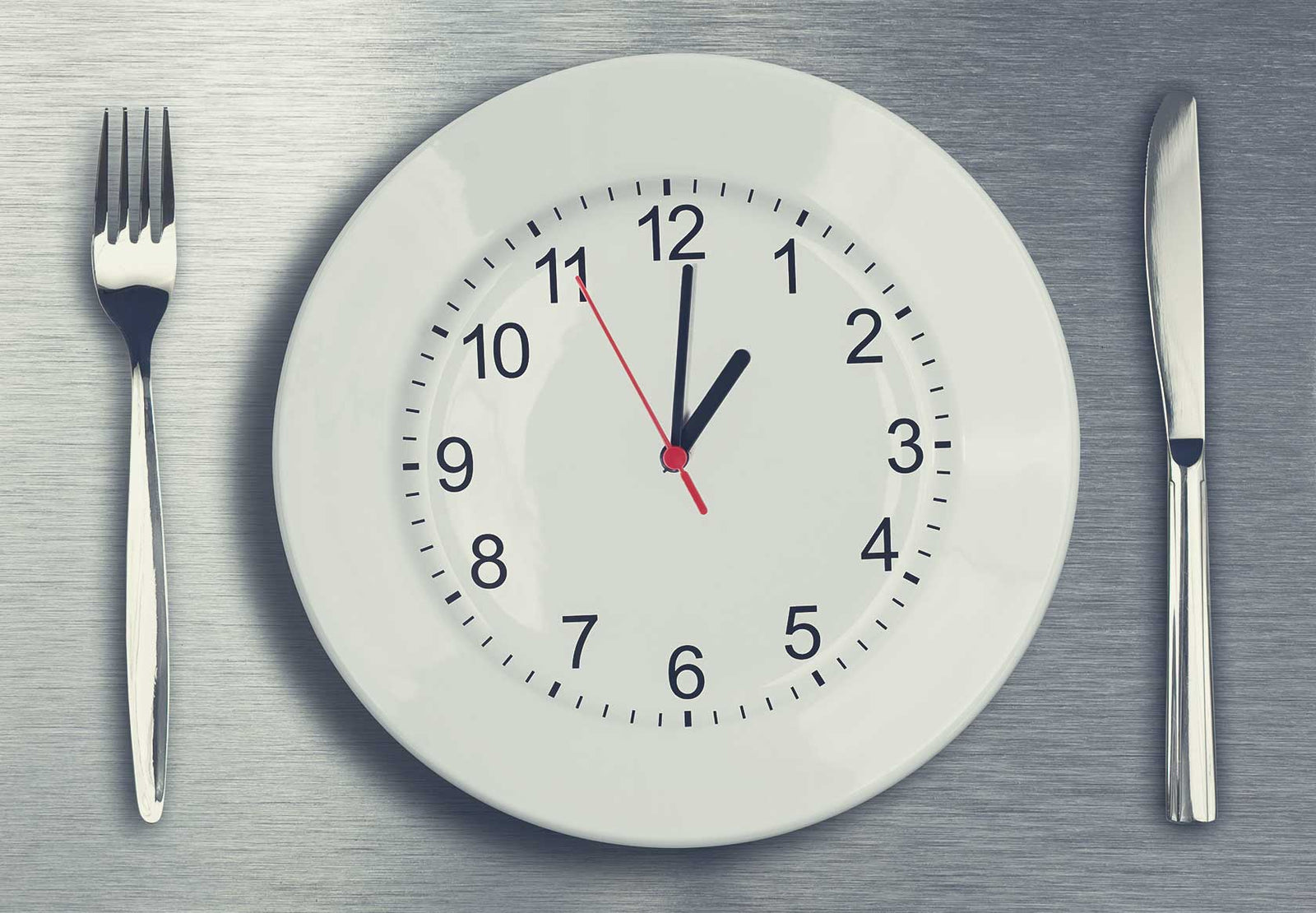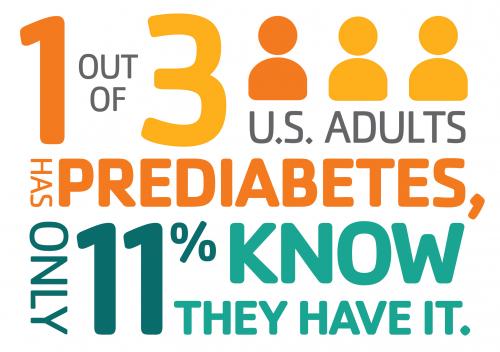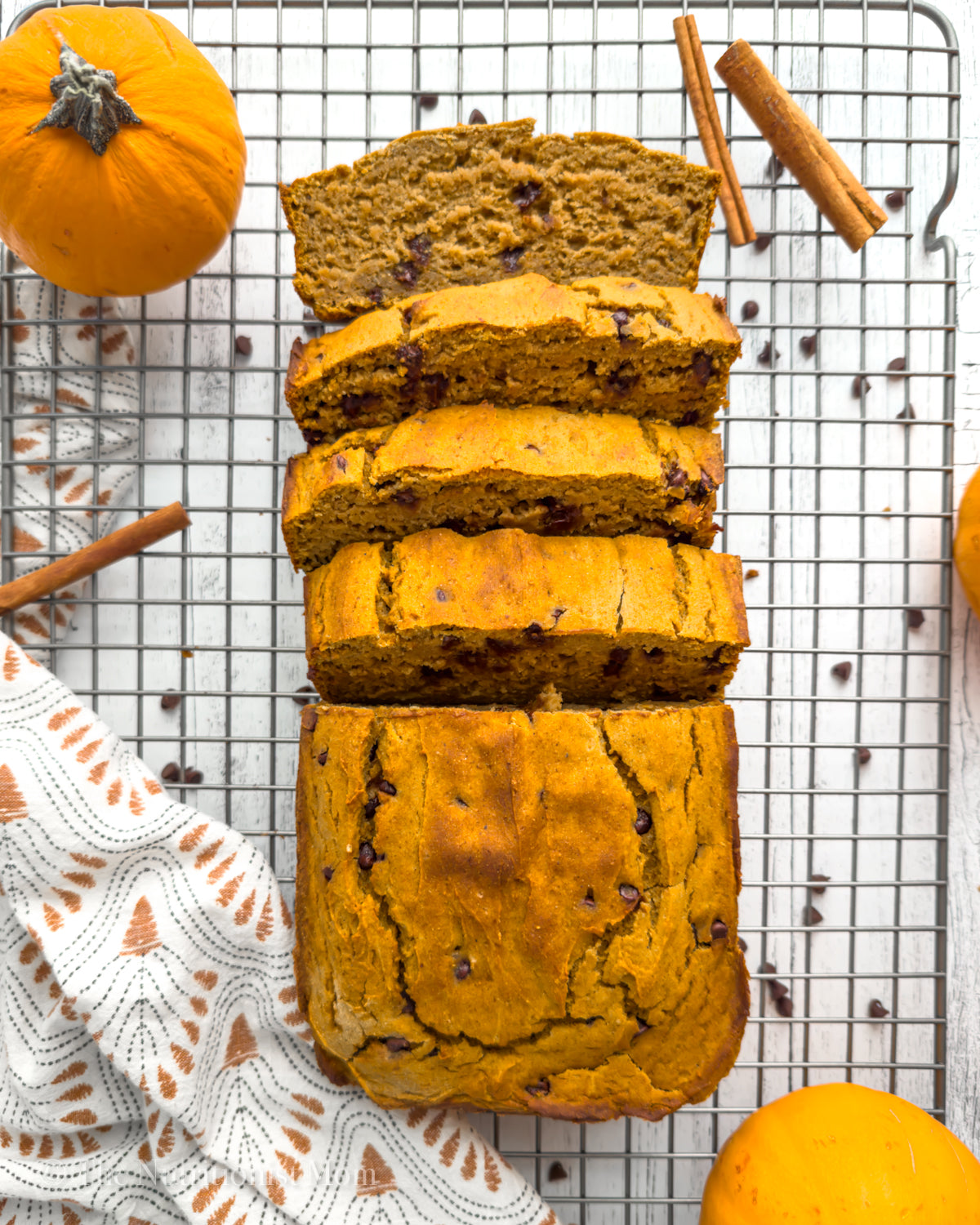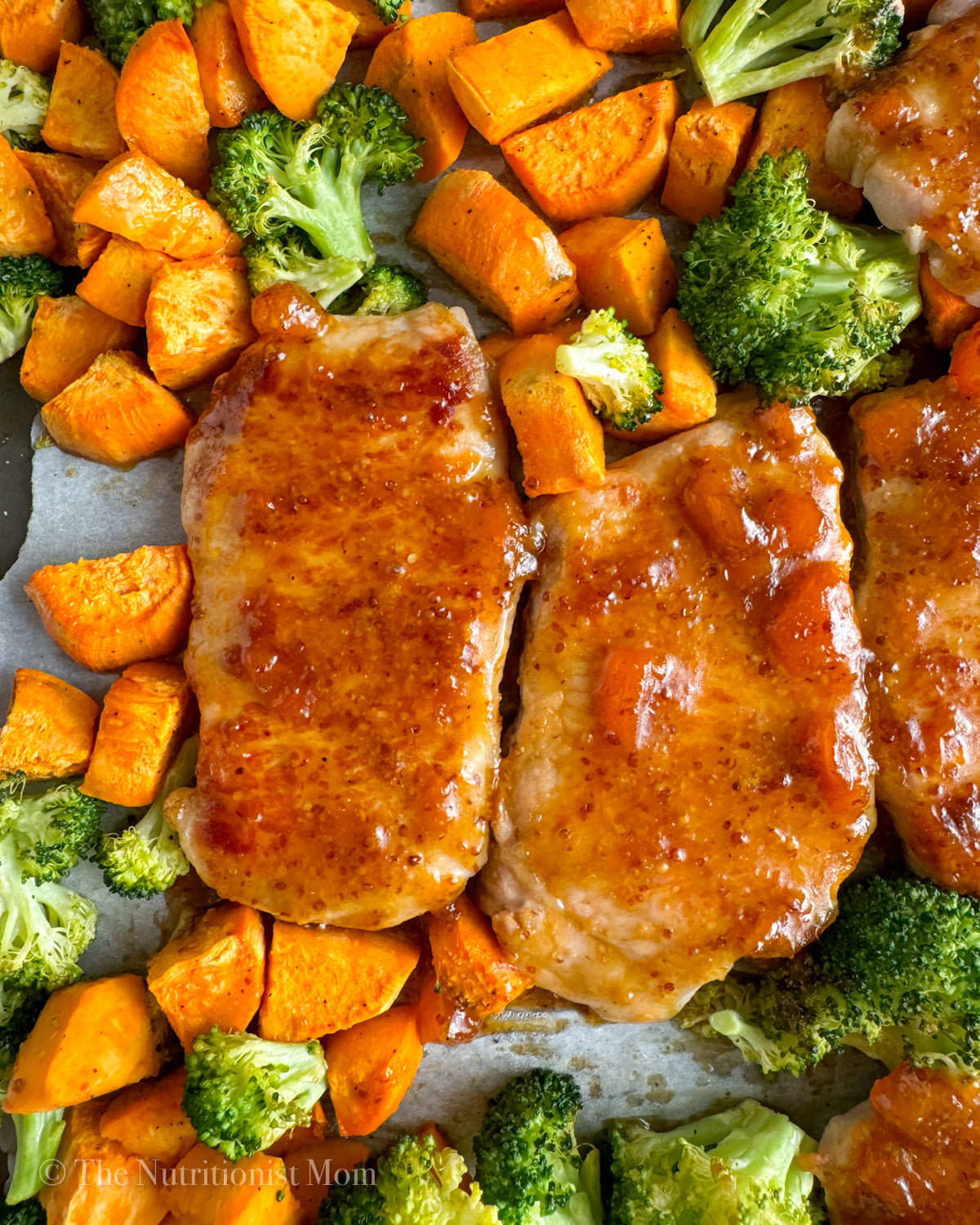WHAT YOU NEED TO KNOW ABOUT INTERMITTENT FASTING

I first experimented with intermittent fasting when I hit a serious plateau prepping for a fitness competition. I was already training over an hour per day, doing 20-30 minutes of fasted cardio in the mornings, eating impeccably clean, drinking a gallon a day, sleeping 7 hours per night, and taking all my supplements. My calories were down to 1,500kcal, so I didn’t feel like I could safely go any lower without bingeing or completely crashing.
In a desperate attempt to budge the scale, I tried intermittent fasting. And guess what, it worked! The scale started trending down with no changes to my training or macros. Naturally, this led me to research why intermittent fasting might be better for fat loss, whether muscle loss was a concern, and how healthy it was long term.

WHAT IS INTERMITTENT FASTING?
Intermittent fasting is simply eating during set “feeding periods” with prolonged “fasting periods” in between. For example, I would fast from 9:00pm until 1:00pm the next day. In other words, a 16-hour fast with an 8-hour feeding period to fit in my macros. This is known as the 16:8 Method, a type of time-restricted fasting coined the “Lean Gains” protocol by Mark Berkhan.
Other popular methods of intermittent fasting include “Eat-Stop-Eat” and “The 5:2 Diet.” Eat-Stop-Eat requires a full 24-hour fast one or two days of the week with normal eating the other days. The 5:2 Diet involves restricting calories to 500-600 calories on two nonconsecutive days of the week, with unrestricted eating the other 5 days.
Another method, called Alternate-Day Fasting, is similar to the 5:2 diet. With this method, you restrict calories by about 75% every other day and eat according to hunger on “in-between” days. This method has been shown effective in obese populations.
The 16:8 Method is the most popular and the only method I’ve really tried, for reasons I will address later on. In general, intermittent fasting is limited to either a daily fasting period or one to two days per week, not fasting several days or weeks in a row.

WHAT ARE THE BENEFITS OF INTERMITTENT FASTING?
1. Appetite Suppression
The first thing I noticed with intermittent fasting was appetite suppression. Intermittent fasting reduces appetite1 through several mechanisms in the body. Fasting causes your body to burn ketones from fatty acids and amino acids instead of glucose. Ketones have been extensively studied to suppress appetite.2 Though most people need to fast for 48 hours or longer to achieve full ketosis, blood ketones are still elevated with shorter fasts.
Fasting also increases levels of the hormone norepinephrine (aka noradrenaline), which suppresses appetite.3 Interestingly, fasting for 24 hours or less does not significantly increase ghrelin or cortisol levels (two hormones that increase appetite), in men or women.4-6 Fasting for longer than 24 hours, however, may result in elevated cortisol levels and increased physiological stress, both of which can induce hunger.7
Another factor that may reduce appetite during intermittent fasting is having bigger, more satisfying meals. For example, you might eat three 600-calorie meals rather than six 300-calorie meals.
Not having food as an option may also help some people take their minds off eating. In my experience, the more I focus on food, the more I want to eat!

2. Enhanced Fat Burning
I first tried intermittent fasting in a desperate attempt to force additional fat loss. Now I know intermittent fasting definitely boosts fat loss… for multiple reasons.
For one, fasting allows insulin levels to fall, stimulating fat burning.8 Every time we eat (carbs, protein, even fats!9), insulin levels increase, temporarily inhibiting lipolysis (fat burning).10 It makes sense then, that fat burning happens when we fast between meals.
Secondly, a 24-hour fast increases Human Growth Hormone (HGH) by over 300% in men, and over 200% in women.11 HGH is one of the few hormones that promotes both fat burning and muscle growth! Over a six-month study, subjects administered HGH increased muscle mass by an average of 5.7 pounds and decreased body fat by an average of 4.8 pounds compared to the control group.12
Not surprisingly, boosting HGH naturally with fasting is much safer than using artificial HGH injections, which have been associated with a number of potential side effects.13,14
But that’s not all! Due to increased norepinephrine (noradrenaline), a 24-hour fast can boost metabolic rate as much as 14%.15 In other words, someone who normally burns 2,000kcal per day burns an extra 282kcal. This phenomenon has been observed in both men and women, and continues until day 2-3 of fasting. Around day 3-4 of fasting, metabolic rate starts to fall (a survival mechanism).
Finally, reducing meal frequency and the number of daily meals could mean fewer calories consumed. Fewer calories in plus increased calories out generally equals greater fat loss, which is what we see with intermittent fasting.

3. Muscle Maintenance
Now for the burning question: can you maintain or even gain muscle while intermittent fasting? Well yes, but it’s no better for muscle-building than six meals per day, given comparable macronutrient ratios.16,17
Although fasting athletes show higher HGH levels, they also measured lower testosterone levels, which could explain why there was no noticeable difference in muscle growth (testosterone is also key for muscle growth).16 However, the fasting athletes did shed more body fat over 8 weeks than those on the standard plan!
Intermittent fasting isn’t better for building muscle, but it may be superior for preserving muscle while dieting, compared to constant calorie restriction.18 It’s hard to say for sure, since the available studies didn’t control macronutrient intake.
We do know protein starts getting broken down for energy around day 3-4 of fasting, as indicated by increased urea-nitrogen.15 So, it takes several days before you start “burning muscle.” Muscle loss is simply not a concern if you’re following the 16:8 method and getting adequate protein.

4. Diabetes Prevention
The different forms of intermittent fasting have varied success in preventing type 2 diabetes.
In a 2016 study, pre-diabetic men following a time-restricted fasting protocol (6-hour daily feeding window) experienced increased insulin sensitivity and blood sugar control, decreased blood pressure, improved pancreatic function, and reduced appetite compared to men following a standard 12-hour feeding schedule.19
Time-restricted fasting also appears to improve blood sugar control in healthy men, and to a lesser extent, women.20 In type 2 diabetics, time-restricted fasting improves blood sugar control (a little), but not insulin resistance.21
When it comes to alternate-day fasting, a 2014 review stated the method is “no more effective” than standard dieting for lowering insulin levels, improving insulin resistance, or reducing visceral belly fat (a risk factor for diabetes).22 A 2012 study actually revealed worse blood sugar control in healthy women after three weeks of alternate-day fasting (fasting every other day).23
Finally, the 5:2 Method of intermittent fasting has been shown to improve insulin levels, inflammation, and visceral fat; but not so much blood glucose levels.20,24
More research needs to be done, especially in women, before intermittent fasting can be recommended for the prevention or treatment of type 2 diabetes. All things considered, time-restricted fasting (like the 16:8 method) shows the most promise.

5. Improved Heart Health
The different modes of intermittent fasting also have unique benefits for heart health.
Time-restricted fasting (like the 16:8 method) promotes beneficial changes in blood triglycerides, LDL and HDL cholesterol levels, as well as overall inflammation levels.16,20,24,25
Alternate-day fasting has been shown to improve inflammatory markers, blood triglycerides, and HDL cholesterol, but can increase unhealthy LDL cholesterol.20 Overall though, the method seems to reduce heart disease risk.
The 5:2 method greatly improves inflammatory markers, with mixed results in lowering triglycerides or cholesterol levels.20,24
Intermittent fasting has some notable benefits for heart health. Being the easiest to follow and having the most positive results, the 16:8 method seems best for improving heart health.

6. Cancer & Disease Prevention
Could fasting be protective against cancer and disease? Studies definitely support the notion. Various intermittent fasting protocols have been shown to improve markers of oxidative stress and inflammation.24-27
Oxidative stress is a key driver of chronic diseases like cancer, heart disease, diabetes, stroke, rheumatoid arthritis and other types of chronic inflammation, as well as aging and degenerative diseases like Alzheimer’s disease, Parkinson’s disease.28
Chronic inflammation also exacerbates numerous disease states and health conditions such as cancer, heart disease, diabetes, insulin resistance, thyroid disease, obesity, Cushing’s disease, Celiac disease, Crohn’s disease, ulcerative colitis, inflammatory bowel disease, Alzheimer’s, rheumatoid arthritis, allergies, and asthma.29
Besides improving markers of oxidative stress and chronic inflammation, intermittent fasting promotes positive changes in gene expression that help our cells cope with stress, and, resist disease and cancer.30,31
Similar benefits have been found with continuous calorie restriction, but intermittent fasting may be more practical long-term.24
Intermittent fasting also facilitates autophagy, a key cellular repair and waste removal mechanism that prevents cancer, disease, and aging.32-34 Over time, defective proteins build up inside your cells and limit functionality. When you fast, your cells literally “eat up” these broken proteins, allowing the cells to operate efficiently.

7. Enhanced Brain Health
Many of the benefits associated with intermittent fasting also foster brain health, such as reduced oxidative stress, reduced inflammation, reduced blood sugar levels and insulin resistance, and enhanced autophagy.
With Alzheimer’s, cellular waste clogs neuron connections and cuts off blood supply to brain cells. Intermittent fasting promotes autophagy in the brain, helping to clean up the neuronal “mess” and restore brain functioning.30
Intermittent fasting also boosts brain-derived neurotrophic factor (BDNF), a factor that’s low in populations suffering from depression, Alzheimer’s, Parkinson’s and Huntington’s diseases.35
Furthermore, the 16:8 method has been shown to increase the growth of new brain cells (neurogenesis), at least in mice.36 Higher rates of neurogenesis have been linked to improved brain performance, memory, focus, and mood.
The increase in norepinephrine that comes with intermittent fasting further increases alertness, memory, and focus (but can also cause restlessness and anxiety).

8. Longevity & Anti-Aging
Due to reduced cellular debris and oxidative stress, intermittent fasting is a very promising anti-aging approach.
Scientists have identified seven factors that cause aging: genome damage, epigenetic factors, telomere shortening, unfolded protein response, mitochondrial dysfunction, cellular senescence and stem cell exhaustion. Intermittent fasting has been shown to diminish at least three of these!20,24,30-34
In rodents, alternate day fasting extends lifespan up to 30%, but more studied are needed in humans.37Again, similar benefits have been discovered with continuous calorie restriction, that is, consistently eating below your calculated energy requirement.

9. It’s How Our Ancestors Ate
Finally, intermittent fasting was how our ancestors ate. Even modern hunter-gatherers don’t have immediate access to food like we do. In fact, they typically spend the morning acquiring food then eat much later in the day.38 This goes to show that our bodies are perfectly capable of adapting to an intermittent fasting lifestyle– it’s what we were designed to do.
ARE THERE NEGATIVES OF INTERMITTENT FASTING?
1. Women May Not Tolerate It As Well
Females present some negative responses to intermittent fasting, such as impaired blood sugar control, reduced fertility and sex hormones, and menstrual abnormalities. These negative effects are mainly seen with the Eat-Stop-Eat38 and alternate-day fasting protocols.23 This is why I recommend women stick to the 16:8 method, or even just 12 hours of fasting if they have a history or menstrual irregularities or hormone issues. Research tells us that women are more susceptible to hormone imbalance from energy restriction and stress (fasting is a form of stress) than men are.38,39
In addition, pregnant and breastfeeding women have increased energy demands, which can be hard to meet with intermittent fasting. I’ve personally found I do best with six small meals while pregnant and breastfeeding, otherwise I experience low energy and dips in my supply.

2. May Exacerbate Hormone Imbalance
Men with clinically low testosterone may not want to try intermittent fasting since it’s been shown to lower testosterone (even if only slightly).16
Those with adrenal insufficiency may not well suited to intermittent fasting either. Fasting causes a stress response that an impaired adrenal system may not be equipped to handle, potentially exacerbating high cortisol levels and hormone imbalance.
Those with thyroid issues like hyperthyroidism or Grave’s disease typically have trouble maintaining weight and should avoid any kind of fasting. People with hypothyroidism or Hashimoto’s should also be cautious with intermittent fasting, since fasting can exacerbate poor blood sugar control and hormone swings. On the other hand, others have reported great results limiting calorie intake to 8 daylight hours, to help regulate normal circadian rhythm.40

3. It’s Not For Everyone
Individuals struggling with eating disorders should not try intermittent fasting, as it can promote overly restrictive behaviors or binge-eating during the feeding window.
Intermittent fasting is not recommended for type 1 diabetics either, since going without food for 16 hours puts them at risk for severe hypoglycemia. That said, some have reported success manipulating their basal insulin via pump or injections. Obviously, this tactic should be closely guided by a medical professional.
People who take medications for blood pressure or heart disease, as well as those in need of regular food intake for medications, should consult their doctor before trying intermittent fasting.
Some experience digestive issues from fasting and feasting, while others find it difficult to enjoy the social aspects of eating. Still others have headaches or difficulty sleeping. It’s not for everyone, that’s for sure!

WHAT TYPE OF INTERMITTENT FASTING IS BEST?
The type of intermittent fasting that is best for both men and women, preservation of muscle mass along with fat burning, diabetes prevention, and heart health is the 16:8 method. The 5:2 method seems best at reducing inflammation, while alternate day fasting is the most studied for longevity. This is not to say the 16:8 method can’t provide similar benefits!
FREQUENTLY ASKED QUESTIONS
Now that you know everything there is to know about intermittent fasting, you may be wondering how to actually apply it.
“When should I fast and when should I eat?”
If you’re doing the 16:8 method of intermittent fasting (recommended), you will be sleeping through about half of your 16-hour fast. The remainder of your fast will either fall in the hours leading up to bedtime or in the morning/early afternoon hours after you wake. Plan your 8-hour feeding window during a time that works best for your training and social schedule.
For example, if you train at 7am each day, perhaps a 9am-5pm feeding window works best for you, or you can train in the middle of your feeding window, as I do. If eating dinner with the family is a priority, try fitting your meals in between 1pm-9pm.
Intermittent fasting is extremely flexible, so you don’t have to fast the same timeframe each day, so long as you’re fasting for 16 hours in a 24-hour period (maybe less if you’re a woman).

“Will fasted training cause muscle loss?”
Contrary to popular belief, training in the fasted state does not cause muscle loss.41,42 It does reap beneficial performance adaptations however!43 That said, I do recommend getting a post-workout meal with at least 25 grams of quality protein within 3 hours post-workout to enable muscle repair and growth.44-46
“Is there a limit to how much protein I can digest at a meal?”
I am so glad you asked – because yes there is! A recent study estimated that the amount of protein your body will use from a single meal is roughly 0.4 gram per kilogram (0.2 grams per pound) of bodyweight.47 Knowing that we need about 1.6 grams per kilogram (0.8 grams per pound) daily to maximize muscle growth, four meals would seem ideal to fully max out lean gains (4 meals x 0.4g/kg/meal = 1.6g/kg).
However, this study has some gaps:48 For one, strength training increases the amount of protein your body can utilize at a single meal beyond 0.4 grams per kilogram. Two, a mixed meal has a greater ability to reduce protein breakdown compared to the whey protein used in this study. Third, fasting increases the anabolic response to a meal, increasing the amount of protein utilized at a single meal beyond 0.4 grams per kilogram. All things considered, I would still aim for three to four meals during your 8-hour feeding window, if you goal is to maximize muscle growth.

“Do I still need to track macros?”
Yes, you should keep tabs on your nutrition. You still need adequate calories and macronutrients, as well as nutrient-dense whole foods for the majority of your diet. Fasting doesn’t change what you need to eat, just when you need to eat it!
I hope you’ve found this article informative and easy enough to understand. If you have any questions, feel free to comment below!
No part of this article may be reproduced, copied, modified or adapted, without written permission from Sarah Wilkins. Violation is subject to prosecution by copyright law, and punishable by up to 5 years in Federal prison and a fine up to $250,000.
Sources:
- Sutton, Elizabeth F., et al. “Early Time-Restricted Feeding Improves Insulin Sensitivity, Blood Pressure, and Oxidative Stress Even without Weight Loss in Men with Prediabetes.” Cell Metabolism, vol. 27, no. 6, 2018, doi:10.1016/j.cmet.2018.04.010.
- Stubbs, Brianna J et al. “A Ketone Ester Drink Lowers Human Ghrelin and Appetite” Obesity (Silver Spring, Md.) vol. 26,2 (2017): 269-273.
- Wellman, Paul J. “Norepinephrine and the Control of Food Intake.” Nutrition, vol. 16, no. 10, 2000, pp. 837–842., doi:10.1016/s0899-9007(00)00415-9.
- Muller, A., et al. “Ghrelin Drives GH Secretion during Fasting in Man.” European Journal of Endocrinology, vol. 146, no. 2, Jan. 2002, pp. 203–207., doi:10.1530/eje.0.1460203.
- Chao, Ariana M et al. “Stress, cortisol, and other appetite-related hormones: Prospective prediction of 6-month changes in food cravings and weight” Obesity (Silver Spring, Md.) vol. 25,4 (2017): 713-720.
- Mazurak, N, et al. “Effects of a 48-h Fast on Heart Rate Variability and Cortisol Levels in Healthy Female Subjects.” European Journal of Clinical Nutrition, vol. 67, no. 4, 2013, pp. 401–406., doi:10.1038/ejcn.2013.32.
- Nakamura Y., Walker B.R., Ikuta T. “Systematic review and meta-analysis reveals acutely elevated plasma cortisol following fasting but not less severe calorie restriction.” Stress. 2015;19:1–21. doi: 10.3109/10253890.2015.1121984.
- Leonie K Heilbronn, Steven R Smith, Corby K Martin, Stephen D Anton, Eric Ravussin; “Alternate-day fasting in nonobese subjects: effects on body weight, body composition, and energy metabolism.” The American Journal of Clinical Nutrition, Volume 81, Issue 1, 1 January 2005, Pages 69–73, https://doi.org/10.1093/ajcn/81.1.69
- Cen, Jing, et al. “Fatty Acids Stimulate Insulin Secretion from Human Pancreatic Islets at Fasting Glucose Concentrations via Mitochondria-Dependent and -Independent Mechanisms.” Nutrition & Metabolism, vol. 13, no. 1, 2016, doi:10.1186/s12986-016-0119-5.
- Chakrabarti, Partha et al. “Insulin inhibits lipolysis in adipocytes via the evolutionarily conserved mTORC1-Egr1-ATGL-mediated pathway.” Molecular and cellular biology vol. 33,18 (2013): 3659-66.
- Ken H. Darzy, Robert D. Murray, Helena K. Gleeson, Suzan S. Pezzoli, Michael O. Thorner, Stephen M. Shalet; “The Impact of Short-Term Fasting on the Dynamics of 24-Hour Growth Hormone (GH) Secretion in Patients with Severe Radiation-Induced GH Deficiency.” The Journal of Clinical Endocrinology & Metabolism, Volume 91, Issue 3, 1 March 2006, Pages 987–994, https://doi.org/10.1210/jc.2005-2145
- Newman, Connie B., et al. “Effects of Low Dose versus High Dose Human Growth Hormone on Body Composition and Lipids in Adults with GH Deficiency: a Meta-Analysis of Placebo-Controlled Randomized Trials.” Pituitary, vol. 18, no. 3, Sept. 2014, pp. 297–305., doi:10.1007/s11102-014-0571-z.
- Divall, Sara A and Sally Radovick. “Growth Hormone and Treatment Controversy; Long Term Safety of rGH” Current pediatrics reports vol. 1,2 (2013): 128-132.
- “Human Growth Hormone (HGH): Does It Slow Aging?” Mayo Clinic, Mayo Foundation for Medical Education and Research, 25 Oct. 2016, www.mayoclinic.org/healthy-lifestyle/healthy-aging/in-depth/growth-hormone/art-20045735.
- Christian Zauner, Bruno Schneeweiss, Alexander Kranz, Christian Madl, Klaus Ratheiser, Ludwig Kramer, Erich Roth, Barbara Schneider, Kurt Lenz; “Resting energy expenditure in short-term starvation is increased as a result of an increase in serum norepinephrine.”The American Journal of Clinical Nutrition, Volume 71, Issue 6, 1 June 2000, Pages 1511–1515, https://doi.org/10.1093/ajcn/71.6.1511
- Moro, Tatiana et al. “Effects of eight weeks of time-restricted feeding (16/8) on basal metabolism, maximal strength, body composition, inflammation, and cardiovascular risk factors in resistance-trained males” Journal of translational medicine vol. 14,1 290. 13 Oct. 2016, doi:10.1186/s12967-016-1044-0
- Tinsley, Grant M, et al. “Intermittent Fasting Combined with Resistance Training: Effects on Body Composition, Muscular Performance, and Dietary Intake.” Journal of the International Society of Sports Nutrition, vol. 12, no. S1, 2015, doi:10.1186/1550-2783-12-s1-p38.
- Varady, K. A. (2011), “Intermittent versus daily calorie restriction: which diet regimen is more effective for weight loss?” Obesity Reviews, 12: e593-e601. doi:10.1111/j.1467-789X.2011.00873.x
- Sutton, Elizabeth F., et al. “Early Time-Restricted Feeding Improves Insulin Sensitivity, Blood Pressure, and Oxidative Stress Even without Weight Loss in Men with Prediabetes.” Cell Metabolism, vol. 27, no. 6, 2018, doi:10.1016/j.cmet.2018.04.010.
- Patterson, Ruth E., and Dorothy D. Sears. “Metabolic Effects of Intermittent Fasting.” Annual Review of Nutrition, vol. 37, no. 1, 2017, pp. 371–393., doi:10.1146/annurev-nutr-071816-064634.
- Arnason, Terra G et al. “Effects of intermittent fasting on health markers in those with type 2 diabetes: A pilot study” World journal of diabetes vol. 8,4 (2017): 154-164.
- Barnosky, Adrienne R., et al. “Intermittent Fasting vs Daily Calorie Restriction for Type 2 Diabetes Prevention: a Review of Human Findings.” Translational Research, vol. 164, no. 4, 2014, pp. 302–311., doi:10.1016/j.trsl.2014.05.013.
- Heilbronn, L. K., Civitarese, A. E., Bogacka, I. , Smith, S. R., Hulver, M. and Ravussin, E. (2005), Glucose Tolerance and Skeletal Muscle Gene Expression in Response to Alternate Day Fasting. Obesity Research, 13: 574-581. doi:10.1038/oby.2005.61
- Patterson, Ruth E et al. “Intermittent Fasting and Human Metabolic Health” Journal of the Academy of Nutrition and Dietetics vol. 115,8 (2015): 1203-12.
- Marinac, Catherine R et al. “Frequency and Circadian Timing of Eating May Influence Biomarkers of Inflammation and Insulin Resistance Associated with Breast Cancer Risk” PloS one vol. 10,8 e0136240. 25 Aug. 2015, doi:10.1371/journal.pone.0136240
- Johnson, James B et al. “Alternate day calorie restriction improves clinical findings and reduces markers of oxidative stress and inflammation in overweight adults with moderate asthma” Free radical biology & medicine vol. 42,5 (2006): 665-74.
- Mattson, M, and R Wan. “Beneficial Effects of Intermittent Fasting and Caloric Restriction on the Cardiovascular and Cerebrovascular Systems.” The Journal of Nutritional Biochemistry, vol. 16, no. 3, 2005, pp. 129–137., doi:10.1016/j.jnutbio.2004.12.007.
- Uttara, Bayani et al. “Oxidative stress and neurodegenerative diseases: a review of upstream and downstream antioxidant therapeutic options” Current neuropharmacology vol. 7,1 (2009): 65-74.
- Hunter, Philip. “The inflammation theory of disease. The growing realization that chronic inflammation is crucial in many diseases opens new avenues for treatment” EMBO reports vol. 13,11 (2012): 968-70.
- Martin, Bronwen et al. “Caloric restriction and intermittent fasting: two potential diets for successful brain aging” Ageing research reviews vol. 5,3 (2006): 332-53.
- Zhu, Yueming et al. “Metabolic regulation of Sirtuins upon fasting and the implication for cancer” Current opinion in oncology vol. 25,6 (2013): 630-6.
- Alirezaei, Mehrdad et al. “Short-term fasting induces profound neuronal autophagy” Autophagy vol. 6,6 (2010): 702-10.
- Kim, Insil and John J Lemasters. “Mitochondrial degradation by autophagy (mitophagy) in GFP-LC3 transgenic hepatocytes during nutrient deprivation” American journal of physiology. Cell physiology vol. 300,2 (2010): C308-17.
- Mathew, Robin et al. “Autophagy suppresses tumorigenesis through elimination of p62” Cell vol. 137,6 (2009): 1062-75.
- Mattson, Mark P., et al. “A Neural Signaling Triumvirate That Influences Ageing and Age-Related Disease: Insulin/IGF-1, BDNF and Serotonin.” Ageing Research Reviews, vol. 3, no. 4, 2004, pp. 445–464., doi:10.1016/j.arr.2004.08.001.
- Manzanero, Silvia et al. “Intermittent fasting attenuates increases in neurogenesis after ischemia and reperfusion and improves recovery” Journal of cerebral blood flow and metabolism : official journal of the International Society of Cerebral Blood Flow and Metabolism vol. 34,5 (2014): 897-905.
- Fontana, Luigi and Linda Partridge. “Promoting health and longevity through diet: from model organisms to humans” Cell vol. 161,1 (2015): 106-118.
- Kumar, Sushil, and Gurcharan Kaur. “Intermittent Fasting Dietary Restriction Regimen Negatively Influences Reproduction in Young Rats: A Study of Hypothalamo-Hypophysial-Gonadal Axis.” PLoS ONE, vol. 8, no. 1, 2013, doi:10.1371/journal.pone.0052416.
- Ranabir, Salam and K Reetu. “Stress and hormones” Indian journal of endocrinology and metabolism vol. 15,1 (2011): 18-22.
- National Academy of Hypothyroidism. “What Is Intermittent Fasting and Is It Safe for Thyroid Patients? | NAH.” National Academy of Hypothyroidism, 6 Sept. 2018, www.nahypothyroidism.org/what-is-intermittent-fasting-and-is-it-safe-for-thyroid-patients/.
- Schoenfeld, Brad Jon et al. “Body composition changes associated with fasted versus non-fasted aerobic exercise” Journal of the International Society of Sports Nutrition vol. 11,1 54. 18 Nov. 2014, doi:10.1186/s12970-014-0054-7
- Hackett, Daniel, and Amanda Hagstrom. “Effect of Overnight Fasted Exercise on Weight Loss and Body Composition: A Systematic Review and Meta-Analysis.” Journal of Functional Morphology and Kinesiology, vol. 2, no. 4, 2017, p. 43., doi:10.3390/jfmk2040043.
- Aird, T. P., et al. “Effects of Fasted vs Fed-State Exercise on Performance and Post-Exercise Metabolism: A Systematic Review and Meta-Analysis.” Scandinavian Journal of Medicine & Science in Sports, vol. 28, no. 5, 2018, pp. 1476–1493., doi:10.1111/sms.13054.
- Aragon AA, Schoenfeld BJ: Nutrient timing revisited: is there a post-exercise anabolic window?. J Int Soc Sports Nutr. 2013 Jan 29, 10 (1): 10-15. 5,2783
- Stark, Matthew et al. “Protein Timing and Its Effects on Muscular Hypertrophy and Strength in Individuals Engaged in Weight-Training.” Journal of the International Society of Sports Nutrition 9 (2012): 54. PMC. Web. 17 Aug. 2018.
- Jäger, Ralf et al. “International Society of Sports Nutrition Position Stand: Protein and Exercise.” Journal of the International Society of Sports Nutrition14 (2017): 20. PMC. Web. 17 Aug. 2018.
- Schoenfeld, Brad Jon, and Alan Albert Aragon. “How Much Protein Can the Body Use in a Single Meal for Muscle-Building? Implications for Daily Protein Distribution.” Journal of the International Society of Sports Nutrition, vol. 15, no. 1, 2018, doi:10.1186/s12970-018-0215-1.
- HenselmansFormerly, Menno. “Do You Need 4 Meals per Day for Maximum Growth after All?” MennoHenselmans.com, 13 Dec. 2018, mennohenselmans.com/meal-frequency-science/.
Also in Blog

CHOCOLATE PEANUT PROTEIN CANDY BARS (VEGAN)

PUMPKIN CHIP PROTEIN BREAD (GLUTEN FREE, DAIRY FREE)
This Pumpkin Chip Protein Bread has a rich, tender texture full of pumpkin spice and chocolate chips (no dry protein bread here). The kids and I can't get enough! Best of all, it's gluten-free, dairy-free, nut-free and easily made egg-free and vegan.



